A couple of years ago we had a look at a few different semiautomatic pistols pursuing the reduction of the bore height over the hand. Among several commercial models, we saw a couple of promising prototypes from different periods. While these were highly innovative, they still kept a relatively traditional configuration. What we have here is a novel approach to muzzle rise reduction, developed over the course of several years by an Italian inventor.
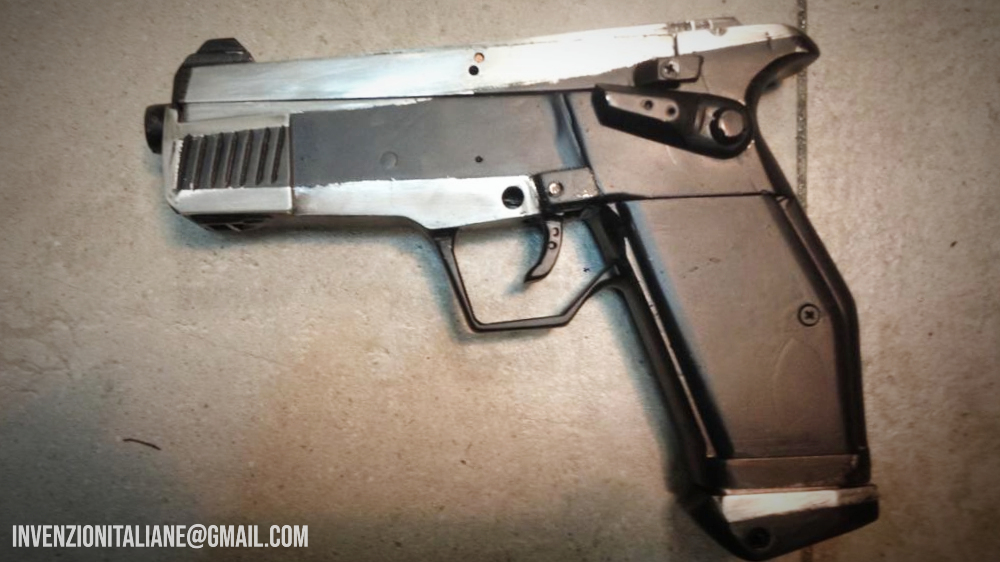
The Quest For The Low Bore Axis: A Novel Italian Approach – Invenzioni Italiane mock-up prototype.
The designer, who prefers to remain anonymous at the moment, sent TFB photos of his mock-up prototype designed around 9mm Luger, and agreed to have a chat with us about his project(s).
The inner workings of the pistol were actually not fully disclosed, but yours truly was able to investigate the previous patents of the designer, whom we’ll now refer to as “Invenzioni Italiane” (Italian Inventions) as his email address.
As the patents, four in total, currently offer IP protection only in Italy, Invenzioni Italiane has some reservations about publishing all details. Apparently, in the past, his openness about releasing info regarding his designs backfired, with solutions reaching the market with no attribution (and compensation) to him.
We are therefore left to wonder about how some of the potential issues, inherent with the solutions adopted, may have been sorted out. Nevertheless, we can see in the prototype a few interesting features that would be cool to see developed in a production model.
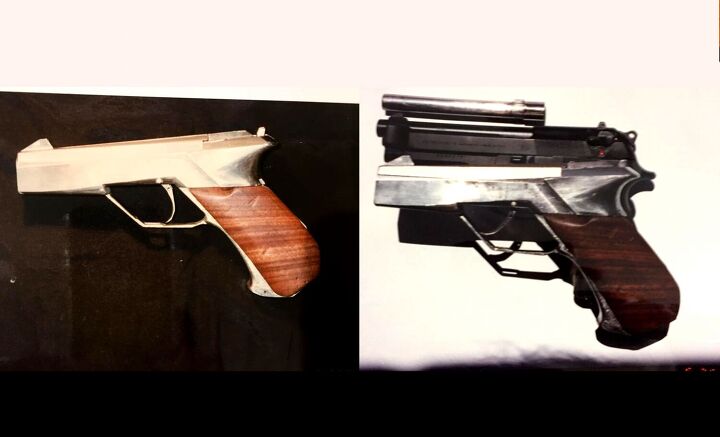
The Quest For The Low Bore Axis: A Novel Italian Approach – The first complete mock-up prototype from Invenzioni Italiane, developed over 30 years ago; note the barrel height compared to Beretta roughly aligned at beavertail height.
The Quest For The Low Bore Axis: A Novel Italian Approach – Blow Forward
The most obvious feature of the pistol is the barrel which appears to be positioned, relative to the hand, at least as low as in the Laugo ALIEN, possibly even lower. Indeed, Invenzioni Italiane claims that dropping it further down would generate a negative muzzle jump upon firing. While we can argue that the Chiappa Rhino may actually have a lower bore axis, we can agree that the prototype reaches the limits of what is physically possible in a semi-auto pistol.
The earliest prototype had an even lower bore axis due to a different, more aggressively angled grip. The latest version, shown in the top photo, has a straighter grip to improve feeding.
At first glance, the beavertail higher than the muzzle, helped by the pattern created by the black paint, give some Jatimatic vibes and one could think that there is a reciprocating mass moving at an angle to the bore axis. This would be a solution allowing to adopt a somewhat conventional rearward moving slide clearing the firing hand. However, this doesn’t appear to be the case.

The Quest For The Low Bore Axis: A Novel Italian Approach – Invenzioni Italiane older prototype.
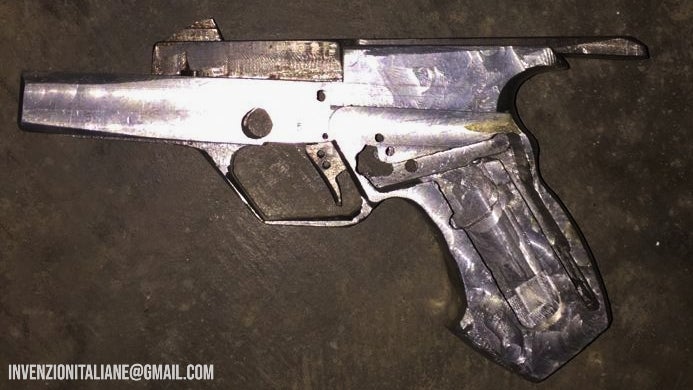
The Quest For The Low Bore Axis: A Novel Italian Approach – Invenzioni Italiane older prototype with the slide locked back.
While in an earlier prototype, shown above, Invenzioni Italiane experimented with a slide flat above the hand, similar in shape to the one in George Wilson’s prototype, in the latest evolution of this concept he seems to have gone the opposite direction.
The pistol appears to adopt the rather uncommon blow forward operating principle, where the breech face is solid to the frame and the barrel is free to move forward, pushed by the friction of the bullet against the rifling. This allows the spent casing to eject from the chamber and a new round to be chambered when the barrel is brought back by the recoil spring.
This type of action is far from new, with the most notable examples being the Schwarzlose M1908 and the Mannlicher M1894. However, with the exception of prototypes, such as this one or, partially, this one, it has no modern interpretation.
Invenzioni Italiane is not employing a direct blow forward system such as the Schwarzlose as it would not be suitable for calibers 9mm Luger and up. Just like in simple blowback versus delayed, higher pressure rounds need solutions to keep the casing from clearing the chamber before the pressure has dropped to safer levels. We can therefore expect a sort of delay or inverted short-recoil approach in this pistol.
The Quest For The Low Bore Axis: A Novel Italian Approach – Striker Fired or…
Given the lack of a rearward moving slide and the limited space between the breech face and the web of the firing hand, the designer must have struggled to come up with a suitable firing action. A striker, like in the Russian prototype linked above, could be a relatively straightforward option.
However, Invenzioni Italiane may have implemented an internal hammer. This would require some accurate management of the available space, but it should be somewhat feasible as a DAO solution.
Previous patents from the designer however suggest a DA/SA setup that re-cocks the hammer thanks to a minimal rearward movement of part of the breech face upon recoil of the casing. This, through proper linkages, allows the hammer to re-set for the next shot. The entire concept looks quite difficult to implement efficiently, but it would definitely be interesting to see.
While the above system was indeed employed in the first prototype, the latest iteration is an SAO model that relies on a different mechanism to re-cock the hammer. Most likely this happens through a mechanical interface between the moving barrel and the trigger group.
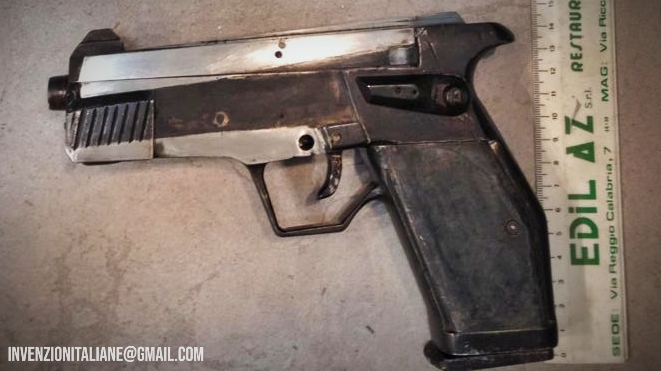
The Quest For The Low Bore Axis: A Novel Italian Approach – Invenzioni Italiane mock-up prototype.
The Quest For The Low Bore Axis: A Novel Italian Approach – No, It Doesn’t Take Glock Mags
Proper feeding tends to be the biggest challenge with new semi-automatic designs with features radically different from traditional layouts. One extreme example could be the Boberg XR9 (now Bond Bullpup 9) that struggled with feeding problems due to its peculiar magazine and feeding cycle.
Clearly, the grip angle of the prototype and its unusual action would not make it compatible with any magazine on the market. Invenzioni Italiane spent indeed a good deal of time perfecting this part of the project. Whereas the main layout of the pistol was devised decades ago, only recently the feeding was sorted to the point of making industrialization a possibility.
Currently, the magazine is a 7-shot single stack one, as adding more rounds through a double stack configuration would have been a monumental effort, with little added value to prove the concept. On the other hand, since Invenzioni Italiane sees the lack of muzzle jump as a perfect opportunity for a machine pistol, a high-capacity magazine would definitely be a future development.
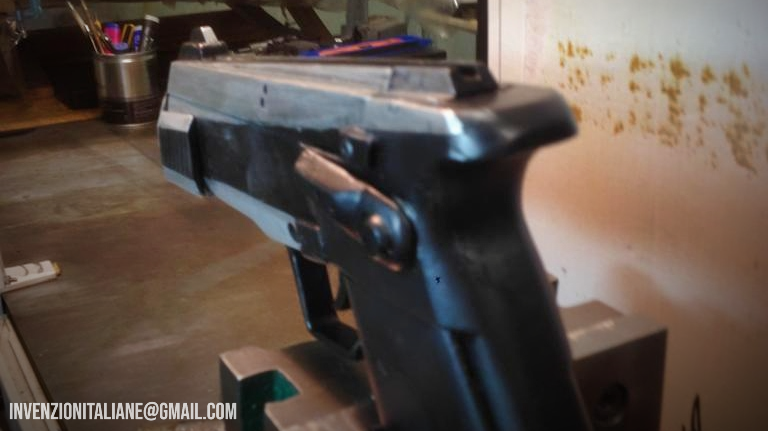
The Quest For The Low Bore Axis: A Novel Italian Approach – Invenzioni Italiane mock-up prototype; detail of the rear sight; having the top of the beavertail hosting an RDS may be relatively simple and advantageous as that area is fixed.
The Quest For The Low Bore Axis: A Novel Italian Approach – What Next
The photos shown here depict a homemade, non-functional mock-up, fully compliant with the Italian laws. However, over the years, Invenzioni Italiane was able to test with licensed partners the principles of his designs and he now has a product ready for manufacturing.
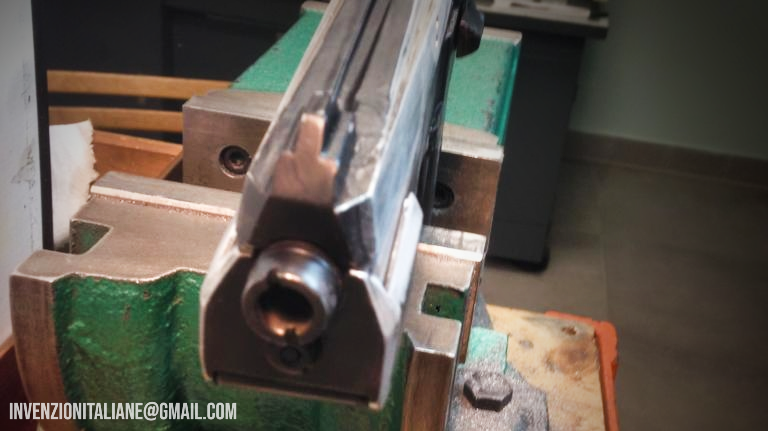
The Quest For The Low Bore Axis: A Novel Italian Approach – Invenzioni Italiane mock-up prototype, view from the muzzle; the front sight appears taller than usual due to the low position of the barrel.
What he lacks is an actual contract with a manufacturer, and given how risk-averse bigger players in the firearms industry seem to be in modern times, this does not come as a surprise.
The pistol does not share a single part with existing models, however, it is designed with economy of components in mind, a well-known winning strategy. The designer for example claims that a single spring covers 10 different functions. While disassembly and re-assembly are reportedly easy, some pieces are definitely complex in shape.
With the above premises on the table, we can also see that there are still smaller manufacturers truly capable of innovating, and proper implementation of modern technologies may help in embarking on bringing to market such a unique system.
We can only hope that these few lines and photos may interest a manufacturer bold enough to decide to manufacture something so new and uncommon. Should you be that entrepreneurial mind, feel free to contact the designer at the email listed in the photos.
 Your Privacy Choices
Your Privacy Choices
